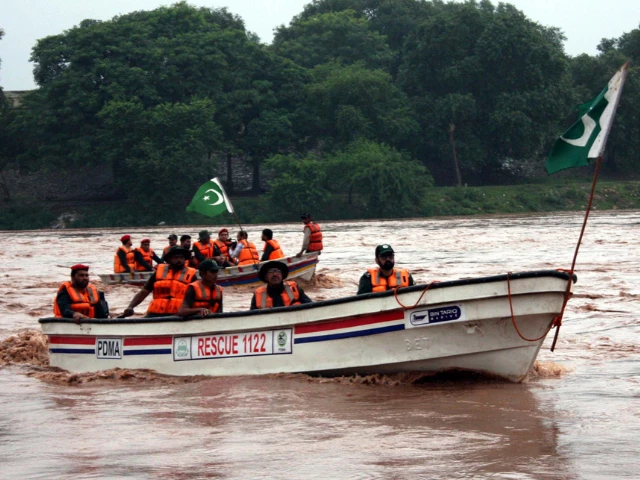In response to the ongoing serious flood in Narowal district, the local administration has sought the help of the Pakistani army as rising flooding water continues to flood large cuts in the region.
The flood has been triggered by the emission of approximately 250,000 CuseC’s water from the Ravi River at Kot Nainan, which immerses large areas of agricultural and residential areas. At the same time, high water levels in the DeK Nullah have added the destruction and puts further load on the local relief effort.
Planning Minister Ahsan Iqbal said in a post on X on Tuesday that the situation in Narowal district had reached emergency levels. He confirmed that although the district administration was actively involved in relief and rescue operations, the gravity of the crisis required the deployment of the army staff.
S ک †یناں کے مقام پر دریائے ر ر OK طغیoud جاری ہے۔
ضلی انظامیہ امدای کاEbolئی میں مصرف ہے، تاہم یلاord کی س سitalگی کے ظ ›ust …
– Ahsan Iqbal (@betterpakistan) August 26, 2025
“The administration is working on the ground, but the severity of the flood has led us to request the support of the Pakistani army,” he said. He urged citizens to remain vigilant, avoid unnecessary movement in the affected areas and prioritize their security. The Minister also announced that he was on his way to Narowal to assess the situation on Earth.
Meanwhile, the Provincial Disaster Management Authority (PDMA) warned that the province – including the big city of Lahore – is facing a “very high to unusually high” flood hazard, driven by heavy monsoon rain and India’s decision to emit water from two dams.
According to PDMA, India had opened all gates in Thein Dam and released excess water in Ravi. This development followed a warning that was issued the previous day of a possible discharge from the rapidly filled food hopur damp, which also affected the Ravi River system.
“The flood situation is serious,” said Irfan Ali Kathia, an official of Punjab’s disaster management authority. “The next 48 hours will be critical.”
Read more: PM orders Fast evacuations when floods affect sutlej, ravi and chenab
The National Disaster Management Authority (NDMA) previously estimated that satellite images showed that Thein Dam was already 97% full – a level where water discharge becomes imminent.
India regularly performs such releases when reservoirs surpass capacity; However, the vicinity of the two nuclear -armed nations and lingering tension after conflict has increased sensitivity. Any floods blamed for Indian actions could further strain fragile conditions.
An Indian source of government clarified that the other alarm did not refer to a particular dam. Intense rainfall, the source added, had asked for renewed communication with Pakistan via diplomatic channels, apparently on humanitarian reason to help avert a disaster affecting both countries.
Lots of evacuations in progress
Authorities have increased evacuations – over 190,000 inhabitants of Punjab have been displaced, including nearly 35,000 who voluntarily left after flood warnings began on August 14, according to national officials.
Villages near Ravi, Sutlej and the Chenab rivers are cleared with the help of the army. While the current flooding along these rivers ranges from medium to high, further heavy heavy rain is expected across Punjab and the Pakistani Kashmir for the next 12-24 hours.
“Sixteen villages remain at immediate flood risk,” said Deputy Commissioner Saba Asghar Ali during a place visit in Pasrur near the Indian border. Assistant camps are created with provisions on food, medicine, sanitation and other necessities.
Punjab’s irrigation minister, Kazim Raza Pirzada, observed that “climate change has intensified rainfall in our eastern river basins compared to the past.”
PMD predicts sustained rain, flooding risks
Pakistan Meteorological Department (PMD) predicts widespread rain, wind and thunderstorms Wednesday in northeastern Punjab and Kashmir, with isolated rainfall expected elsewhere in central and southern Punjab, Upper Khyber-Pakhtunkhwa and Northeast and South Balochistan.
Heavy rainfall can trigger landslides and mud lids in hilly areas of Kashmir-Inclusive Rawalakot, Poonch and Mirpur and city flooding in low-lying cities such as Narowal, Sialkot, Gujranwala and Lahore.
Residents have been encouraged to remain cautious as intense weather can affect weak structures, poles, advertising boards and vehicles.
In response to the escalating threat placed Punjab’s inspector for police, dr. Usman Anwar, the police force on high alarm. He directed teams all over the province to help with rescue and evacuation operations-ice in low-lying and flooding villages bordering rivers and streams.
Monitoring managers (RPOs and DPOs) have personally been tasked with overseeing the basic efforts that coordinated closely with district administrations and rescue agencies.
Regular patrolling is underway in affected areas and police ensure the safety of emergency camps and flood -expelled individuals. “The protection of life, property and essential possessions for citizens will be secured at all costs,” IGP states.
Since the monsoon began in late June, flood -related deaths in Pakistan have reached 802, with almost half occurred in August alone. Other regions are affected in a similar way; Gilgit-Baltistan is struggling with accelerated glown melting, and Karachi was partially submerged by flash floods last week.



